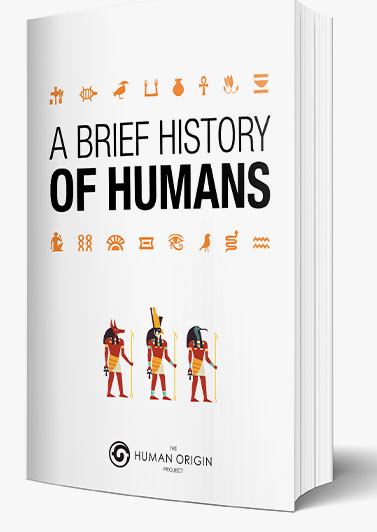Did you know you could be carrying Neanderthal DNA?
Your genome tells the stories of how your ancestors evolved. DNA discovered in fossil records is constantly changing the story of this human evolution.
Research has suggested modern humans living outside of Africa have between 1 and 4 percent of Neanderthal DNA.
How and when did Neanderthal DNA wind up in the modern human’s genome? Scientists have been trying to establish a time and place for such an interaction between humans and Neanderthals.
Lately, the evidence has grown with multiple instances of interbreeding between the two species having been found.
Let’s go back in time look at the story of Neanderthal DNA.
What is Neanderthal Man?

Image: Neanderthal Man as featured in Mettmann Museum near Düsseldorf. Photo: Don Hitchcock 2015
In 1857, Hermann Schaafhausen, a German anatomist, presented his findings on the Neanderthal man (Homo neanderthalis). Prussian workers cutting limestone in the Neander valley of Germany found its bones inside a cave in 1856.
Named after the Neander valley, this set of Neanderthal bones were not the first to be found. In 1829, similar bones had been discovered, but at the time researchers had been unable to classify them.
Neanderthal man lived across Europe and parts of Asia. Some archaeological remains have been found as far east as Russia. They are thought to have lived between 400,000 and 40,000 years ago.
Recent research has implied that Neanderthals crossed paths with humans at multiple points across space and time.
As scientists look back at Neanderthal man, their theories about his evolution, interaction with modern man and eventual extinction continue to develop.
What is the difference between Neanderthals and humans?

Image: Original recraction of Neanderthal Man, by Atelier Manufaktur, München. Photo: Don Hitchcock 2015 Reference
Neanderthal characteristics are humanoid in nature. Their standout features include a heavy brow, large nose, angular cheekbones, short stature, and often, a larger brain case when compared to a human. Whereas, modern humans are said to have smaller brains and skulls, and smaller noses than Neanderthals.
Also, the Neanderthals were likely much stronger than modern human species or Homo sapiens. Researchers believe they were especially adapted to withstand the harsh winters of the north. While Neanderthals were hunter-gatherers, H. sapiens live a settled life, producing food through agriculture and domestication.
When was the last Neanderthal alive?

Image: Skull characteristics of a Neanderthal head and face. Source: Wikimedia Commons
Neanderthals disappeared from the planet 40,000 odd years ago. In the past, scientists have implicated infiltrating humans, their diseases and possibly murderous tendencies. While many theories for why Neanderthals died out exist, the latest places the blame on climate change. Environmental disasters had been proposed as a cause in the past.
Why did Neanderthals go extinct?
Recently studies have reported that two back-to-back cold spells were the straw that broke the camel’s back. A 1000-year long cold period around 44,000 years ago and another 600-year long spell about 40,800 years ago may have driven the Neanderthals to extinction. The year-round permafrost may have been the final shove for the already-declining species.
Archaeological records corresponding to these cold spells suggest the Neanderthals were dying off. This, at the same time when early humans were advancing out of Africa and encroaching on Neanderthal territory.
Previously, Neanderthals were believed to have become extinct 30,000 years ago. Early humans entered Europe 45,000 years ago. Thus, scientists entertained the idea that modern humans may have decimated Neanderthal man during those 15,000 overlapping years.
New research suggests that Neanderthals reached extinction 40,000 years ago.
The short time span between the advent of one species and departure of the other suggests something besides an all-out war may have been responsible for Neanderthal extinction. Modern humans’ adaptability may have helped them beat out the Neanderthals when it came to lasting through the cold.
The Neanderthal DNA Project
Established in 2006 at the Max Planck Institute for Evolutionary Anthropology, the Neanderthal genome project put forth its first draft of the Neanderthal genome in 2009. While this initial report suggested no genetic overlap between modern humans and Neanderthals, the project published a new set of results that contradicted the previous study.
The study, which came out in 2010, found that modern-day Europeans and Asians—but not Africans—carried Neanderthal DNA. On the other hand, another study found that the Neanderthals did not seem to have gained genetically from their interactions with humans.
Does modern man have Neanderthal DNA?
Yes! As Neanderthals may have mated (multiple times, even!) with humans, modern humans carry a small amount of Neanderthal DNA. Since the sequencing of the first complete Neanderthal genome in 2010, researchers have known that Neanderthals mixed with modern humans.
While humans living in Europe and Asia today have low amounts of Neanderthal DNA, Africans do not. These low levels suggest that modern humans and Neanderthals met but a few times and only outside Africa. These encounters possibly happened in the Middle East or Arabian Peninsula soon after modern humans moved out of Africa.
What percentage of DNA do humans share with Neanderthals?
Between one percent and four percent of DNA belonging to Europeans and East Asians bears surprising resemblance to that of Neanderthals. Moreover, the various snippets of Neanderthal DNA that have been found in modern humans adds up to about 20 percent of the complete Neanderthal genome. But no one human is likely to showcase all 20 percent.
There are some interesting traits Neanderthal DNA could play a role in for humans today.
- Stretches of overlapping DNA are often found in genes that confer traits pertaining to skin or hair.
- Certain genetic mutations known to make individuals more likely to become addicted to smoking have also been noticed.
- Studies have also found Neanderthal traits in genes that alter one’s risk of developing lupus, biliary cirrhosis, Crohn’s disease, and type 2 diabetes.
- These traits may once have proved useful in the environment Neanderthals evolved. For example, the mutation for type 2 diabetes may have helped abate starvation during Neanderthal times.
Neanderthal traits also helped enhanced the immune system.
Researchers suggest the Neanderthal copies of these genes may have been retained as they were beneficial. As humans colonized lands that had once served the Neanderthals, the latter’s adaptations may have proved useful to the former. This likely explains why certain Neanderthal genes were maintained in the genomes of modern humans.
How long did Neanderthals and humans coexist?
It is increasingly understood that modern humans may have come into contact with Neanderthals. Previously, researchers have believed that modern humans, leaving Africa, may have wiped out Neanderthals.
Some believe that humans would have brought with them unique germs to which the Neanderthals may have lacked immunity. Others are of the opinion that humans may have waged many a battle against Neanderthal man.
However, recent evidence has challenged the likelihood that humans and Neanderthals may not have gotten along during their interactions. They may have gotten along all too well.
In 2010, evidence of Neanderthal DNA in present-day humans was first found. Scientists used Neanderthal remains found in Croatia to draft their first complete genome.
Next, they compared the genomes of non-Africans and Neanderthals to help establish whether sexual relations occurred between them.
Indeed, such interactions were reflected in the genome overlaps between the two kinds. The two species may have come across each other in the Middle East around 50,000 to 60,000 years ago and mated.
Could Neanderthals and humans have reproduced?
More recent evidence strengthens the likelihood of such relationships between humans and Neanderthals. A 45,000-year old Romanian human skeleton may have had a Neanderthal great-great grandparent. This interaction was likely to have occurred between 50,000 and 65,000 years ago.
Some researchers are also of the opinion that the ancestors of East Asians may have mingled with Neanderthals a second time, making them more mixed than Europeans.
On the other side of things, the genome of a female Neanderthal has been found to contain bits and pieces of H. sapiens DNA. These may have appeared due to encounters between the two species in the Middle East.
A recent study takes this connection between humans and Neanderthals even further back. The more than 50,000-year old toe bone of a Neanderthal woman was found to have the DNA of an early modern human. The latter do not seem to be represented among the current human population.
These results push back the dates of interactions between the two groups thousands of years back. The researchers suggest that Neanderthals migrating from Europe to Asia may have bumped into an early wave of H. sapiens heading out of Africa.
Thus, humans and Neanderthals seem to have met and mated at multiple spots around the world. New studies help to clarify the extent of these encounters between Neanderthal and modern man.
Is red hair a Neanderthal gene?
Despite what you may have heard, your red-headed friend may not owe their trait to possible Neanderthal DNA. Though they may be able to attribute their height or hairy back to it. The genetic testing company, 23andMe, can now tell you the functions of some of the Neanderthal genetic mutations you have.
While Neanderthals possessed red hair, the mutation that is responsible for their hair colour is not present in modern humans. Present-day humans with red hair have a different mutation in the same gene. So, modern humans with red hair do not owe their Neanderthalic roots for this feature.
Are Neanderthal humans?
At the time of Schaafhausen’s report, confusion reigned about the finding. Superficially, the remains looked quite human. When studied in greater depth, the bones revealed difference that set them apart from a modern human’s skeleton.
So, did the bones belong to the human species or a different one altogether? While significant progress has been made in the study of Neanderthals over the past 150 years, this question still encourages debate.
The Neanderthal man is classified in the same genus, Homo, as modern humans. But not everyone agrees that this is how it should be. According to the classical definition of a species, reproduction between two species—if possible—will result in the birth of sterile progeny.
Archaeological and genomic studies have revealed the presence, albeit minimal, of Neanderthal DNA in today’s humans. This suggests that encounters between the Neanderthals and humans were successful and led to fertile offspring, at least sometimes.
But, this raises questions about the segregation of Neanderthals and humans into separate species. It also throws the very definition of species into doubt. Thus, scientists continue to debate about the classification of Neanderthals.
Conclusion
Neanderthal man walked the planet thousands of years ago. Researchers had always wondered if modern man’s meeting with Neanderthals led to their extinction. Whether this occurred is still unknown.
We do know that modern man met Neanderthal man several times over the course of thousands of years. Often these meetings resulted in matings that sometimes led to fertile offspring.
These matings seem to have occurred across vast expanses but still early on in modern man’s history. This possibly explains why non-African humans have but a small amount of Neanderthal DNA.
Over the years, through the exchange of genetic material, certain Neanderthal genes have been retained in modern humans. While some are beneficial to us, others increase our risk of several diseases. Researchers are not quite certain if modern man left an impact on Neanderthals but the species certainly left its mark on us.
Now it’s up to you. What do you think Neanderthal DNA tells us about human origins?
Further reading:
- https://www.smithsonianmag.com/smart-news/modern-humans-didnt-kill-neanderthals-weather-did-180970167/
https://www.the-scientist.com/daily-news/effects-of-neanderthal-dna-on-modern-humans-30787 - https://www.pbs.org/wgbh/nova/article/are-neanderthals-human/
- https://www.nature.com/news/evidence-mounts-for-interbreeding-bonanza-in-ancient-human-species-1.19394
- https://www.sciencemag.org/news/2016/02/humans-mated-neandertals-much-earlier-and-more-frequently-thought?r3f_986
- https://news.nationalgeographic.com/news/2014/01/140129-neanderthal-genes-genetics-migration-africa-eurasian-science/
- https://www.genome.gov/27539119/2010-release-complete-neanderthal-genome-sequenced/


 Recent research shows that certain people carry Neanderthal DNA. Let’s explore the history of Neanderthal Man
Recent research shows that certain people carry Neanderthal DNA. Let’s explore the history of Neanderthal Man

























